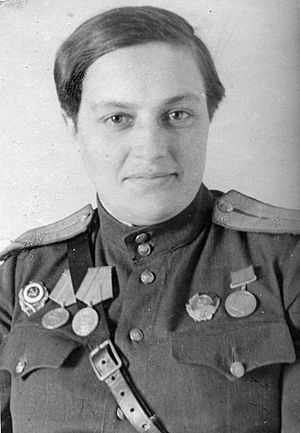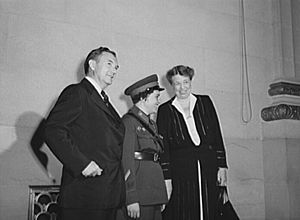Lyudmila Pavlichenko facts for kids
Quick facts for kids
Lyudmila Mikhailovna Pavlichenko
|
|
|---|---|

Lyudmila Pavlichenko in 1940s
|
|
| Native name |
Людмила Михайлівна Павличенко
|
| Birth name | Lyudmila Mikhailovna Belova |
| Nickname(s) | Lady Death |
| Born | 12 July [O.S. 29 June] 1916 Bila Tserkva, Russian Empire (present-day Ukraine) |
| Died | 10 October 1974 (aged 58) Moscow, Russian SFSR, Soviet Union |
| Allegiance | |
| Service/ |
|
| Years of service | 1941–1953 |
| Rank | Lieutenant in the Army Senior Researcher with rank of Major in the Soviet Navy |
| Unit | 54th Stenka Razin Rifle Regiment in 25th Rifle Division Soviet Navy General Staff |
| Battles/wars | World War II
|
| Awards | Hero of the Soviet Union |
| Spouse(s) | Aleksey Pavlichenko Alexei Kitsenko |
| Children | Rostislav Pavlichenko |
| Other work | Soviet Committee of the Veterans of War |
Lyudmila Mikhailovna Pavlichenko (born Lyudmila Mikhailovna Belova; July 12, 1916 – October 10, 1974) was a brave and skilled Soviet sniper in the Red Army during World War II. She is known as one of the deadliest female snipers in history.
Lyudmila Pavlichenko is famous for her incredible skill, with 309 confirmed kills. This makes her the most successful female sniper ever. She fought in major battles like the Siege of Odessa and the Siege of Sevastopol. These battles happened early in the war on the Eastern Front.
After being hurt by a mortar shell, she was sent to Moscow to recover. Once she was better, she became a trainer for other Red Army snipers. She also traveled to other countries to speak about the war. In 1942, she visited the United States, Canada, and the United Kingdom. After the war ended in 1945, she worked as a senior researcher for the Soviet Navy. She passed away at age 58.
Contents
Early Life and Education
Lyudmila Belova was born in Bila Tserkva, which was part of the Russian Empire (now in Ukraine), on July 12, 1916. Her father, Mikhail Belov, was a locksmith. Her mother was Elena Trofimovna Belova.
When Lyudmila was 14, her family moved to Kyiv. As a child, she was very active and competitive, especially in sports. In Kyiv, she joined a shooting club. She became a very good shooter and earned special shooting awards.
In 1932, she married Alexei Pavlichenko. They had a son named Rostislav. However, her marriage ended soon after, and Lyudmila moved back in with her parents. She worked at a factory during the day and went to night school.
In 1937, she started studying history at Kyiv University, hoping to become a teacher. She also ran track and did pole vaulting for the university team. The Red Army also sent her to a special sniping school for six months.
Fighting in World War II
In June 1941, Lyudmila was 25 years old and still studying history at Kyiv University. This was when Nazi Germany invaded the Soviet Union. Lyudmila was one of the first people to volunteer at the Odesa recruiting office. She wanted to join the army as a soldier, even though they first suggested she become a nurse. Because she had completed many training courses, she was accepted as a sniper. She joined the Red Army's 25th Rifle Division.
She was one of 2,000 women who became snipers in the Red Army. Only about 500 of these women survived the war. At first, she was only given a grenade because there weren't enough weapons. On August 8, 1941, a fallen comrade gave her his rifle. With this rifle, Lyudmila shot her first two enemies. She called this her "baptism of fire," meaning it was her official start as a sniper.
Lyudmila fought for about two and a half months during the Siege of Odesa. She is credited with killing 187 enemy soldiers during this time. In August 1941, she was promoted to senior sergeant. She added 100 more kills to her official count. At 25, she married a fellow sniper, Alexei Kitsenko. Sadly, he was badly wounded by a mortar shell and died a few days later.
When the Nazis took over Odesa in October 1941, Lyudmila's unit moved by sea to Sevastopol. There, she fought in the Siege of Sevastopol. She also trained other snipers, who helped kill over 100 enemy soldiers. By May 1942, she was promoted to Lieutenant. She was recognized for killing 257 enemy soldiers. By the end of her combat duty, Lyudmila Pavlichenko was credited with 309 kills. This included 36 enemy snipers.
In June 1942, Lyudmila was hit in the face by shrapnel from a mortar shell. The Soviet leaders ordered her to be taken away from Sevastopol by submarine.
She spent about a month in the hospital. After she recovered, she did not return to the front lines. Instead, she became a public speaker for the Red Army. She was nicknamed "Lady Death." She also trained snipers until the war ended in 1945.
Visits to Other Countries

In 1942, Lyudmila Pavlichenko traveled to Canada and the United States. This was part of the Soviet Union's effort to get other countries to open another front against Nazi Germany. When she visited the United States, she was the first Soviet citizen to meet a US president. President Franklin D. Roosevelt welcomed her to the White House.
Later, First Lady Eleanor Roosevelt invited Lyudmila to tour the US. Lyudmila shared her experiences as a female soldier on the front lines. During her visit, some reporters did not take her seriously. They called her the "Girl Sniper." When she met with reporters in Washington, DC, she was surprised by their questions. One reporter even asked about the length of her uniform skirt. They also asked if she used makeup in battle. Lyudmila was described as very direct and serious in her answers.
Lyudmila spoke at the International Student Assembly in Washington, DC. She also attended meetings and gave speeches in New York City and Chicago. In New York City, Mayor Fiorello H. La Guardia gave her a fur coat. In Chicago, she spoke to large crowds. She encouraged the men to support opening a second front in the war. She famously said, "Gentlemen, I am 26 years old and I have killed 309 fascist invaders by now. Don't you think, gentlemen, that you have been hiding behind my back for too long?" Her words made the crowd cheer loudly. The United States government gave her a special pistol. In Toronto, Canada, she received a Winchester Model 70 rifle with a special scope. This rifle is now in a museum in Moscow.
On November 21, 1942, Lyudmila visited Coventry, England. She accepted donations from workers to buy X-ray machines for the Red Army. She also visited the ruins of Coventry Cathedral and local factories.
After becoming an officer, Lyudmila did not return to combat. Instead, she became an instructor and trained snipers until the war ended. In 1943, she received the highest honor, the Gold Star of the Hero of the Soviet Union. She also received the Order of Lenin twice.
Later Life
After the war, Lyudmila finished her studies at Kyiv University. She then started a career as a historian. From 1945 to 1953, she worked as a research assistant for the Soviet Navy. She was also active in the Soviet Committee of the Veterans of War. In 1957, Eleanor Roosevelt visited Lyudmila in Moscow. Lyudmila faced challenges in her later life, especially related to the loss of her husband in the war.
Death and Legacy
Lyudmila Pavlichenko passed away on October 10, 1974, at the age of 58. She was buried in Novodevichy Cemetery in Moscow, next to her son, Rostislav.
In 1976, a second Soviet stamp was issued with her picture on it, honoring her contributions.
Awards and Honours
- Hero of the Soviet Union (October 25, 1943)
- Two Orders of Lenin (July 16, 1942 and October 25, 1943)
- Two Medals "For Military Merit" (April 26, 1942 and June 13, 1952)
- Campaign medals
See also
 In Spanish: Liudmila Pavlichenko para niños
In Spanish: Liudmila Pavlichenko para niños
- List of female Heroes of the Soviet Union
- Roza Shanina – Another famous female sniper from World War II
- Lydia Litvyak – A female fighter pilot from World War II
- Snipers of the Soviet Union
- Mosin–Nagant


